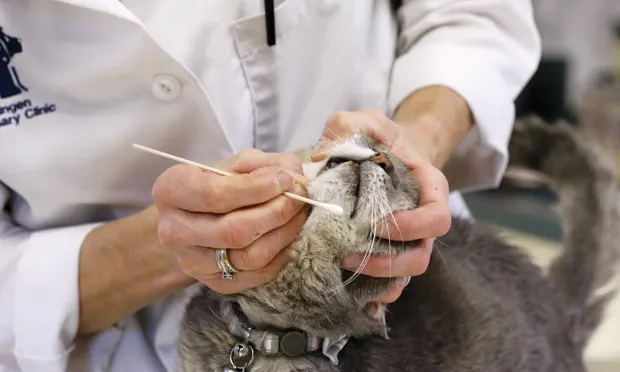Cats Are Different: Identifying Gingivostomatitis in Feline Patients

Stomatitis is defined as inflammation of oral mucous membranes.1 Gingivostomatitis, the clinical veterinary term that indicates chronic inflammation and proliferation of the gingiva and oral mucosa,2 is often frustrating for the veterinary team because it is difficult to diagnose and may require drastic treatment for long-term success. This painful condition can also be difficult for clients and patients.
Gingivostomatitis in cats can be mild to extreme and may result from multiple conditions, but the cause is not truly understood. Various conditions (eg, viral infections, autoimmune responses, exaggerated inflammatory response to bacterial plaque) may be causal factors in the disease.
Related Article: Identifying Pain in Geriatric Patients
Obtaining a History
Some cats are experts at hiding pain, so obtaining a detailed history and conducting a thorough examination is key to making a diagnosis. Ask clients open-ended questions about changes in the cat’s behavior, especially regarding the mouth. For example, ask, Can you tell me the changes you have noticed in your pet’s eating habits?
Clinical signs include:
food dropping
growling or crying while eating
lack of grooming
severe halitosis.
Cats with severe cases may also:
paw at the mouth
cry when yawning
drool excessively
have blood-tinged saliva
change temperament (ie, become aggressive or reclusive).
Abyssinian, Persian, Himalayan, Burmese, Siamese, and Somali breeds are predisposed to gingivostomatitis, although all cats can develop the disease.
Extraction of the caudal teeth is currently the most successful long-term treatment for cats with chronic gingivostomatitis.
Oral Examination
Diagnosis is made by visual oral examination. With a conscious patient, the veterinary team member may be able to gently pull back the lips to determine the amount of inflammation and slowly open the mouth to examine the entire cavity. However, an examination is likely limited without sedating or anesthetizing the patient because of pain.
Related Article: Quiz: Feline Anesthesia Skills for Technicians
It is important to differentiate between periodontal disease and gingivostomatitis because both can present with gingival inflammation. Periodontal disease presents as red, swollen tissue surrounding the teeth, whereas gingivostomatitis presents with a cobblestone-like appearance in the caudal aspect of the mouth and at the gingival margin along the teeth.3 The tissue around the premolars and molars is usually more affected than that around the canines and incisors. In severe cases, the caudal tissue may proliferate, become friable, and bleed easily. The inflamed and proliferative tissue is distributed symmetrically.
Resorptive dental lesions at all stages may appear concurrently with gingvostomatitis.4 Tooth resorption is another painful condition. Although the cause is unknown,2 Type 1 tooth resorption is thought to be triggered by soft-tissue inflammation that activates the odontoclasts.2 Gingivostomatitis may be present in cats with missing teeth; in these cases, oral radiographs are required to identify any evidence of retained roots, which may activate soft-tissue inflammation.2,3,5
Histopathlogic results often describe the tissue as lymphoplasmacytic stomatitis. Gingivostomatis is a clinical condition for which no specific cause has been identified.2 Diagnostic evaluations should include a visual examination of the mouth and a full series of dental radiographs to look for bone loss, retained roots, or neoplastic bony changes to rule out other possible causes of inflammation.
If the inflammation is asymmetrical, ulcerations are present, or radiographs indicate bony changes, a biopsy should be submitted for histopathology; however, identifying lymphocytic-plasmacytic stomatitis only demonstrates a histologic diagnosis and does not provide a specific cause.
Treatment
Because the cause is unknown, no medical treatment achieves consistent results. Current therapeutic options include full-mouth extractions, laser treatment to remove inflammatory tissue, chronic immunosuppressive treatments, anti-inflammatory treatment, antibiotics, and nutraceuticals.5
Extraction of the caudal teeth is currently the most successful long-term treatment for cats with chronic gingivostomatitis.2,5,6 Extractions followed by radiographs help ensure that all root-tip fragments have been removed. In most cases, inflammation affects only the caudal teeth; however, any affected rostral teeth should also be extracted. This drastic treatment is not always successful, however, and the cat may need lifelong multimodal medical management.
Related Article: Image Gallery Dental Diagnoses and Treatment Recommendations
MARY L. BERG, RVT, RLATG, VTS (Dentistry), is president of Beyond the Crown Veterinary Education, a veterinary dental consulting service. She is a charter member of the Academy of Veterinary Dental Technicians and received her veterinary technician specialty in dentistry in June 2006. She has worked in research for more than 13 years, specializing in products aimed at improving the oral health of companion animals and working with industry partners to evaluate product efficacy. Her background also includes research, practice management, writing and publishing, and teaching.
FUN FACT: Mary lives on a small farm in Kansas with her husband and enjoys spending time with her children, grandchildren, and menagerie of pets: Skye, a 14-year-old, shy, temperamental sheltie; Xena, a 9-year-old keeshond; cats Ricochet, Bea, and Baxter; 2 senior citizen horses; multiple barn cats; and a small flock of sheep.